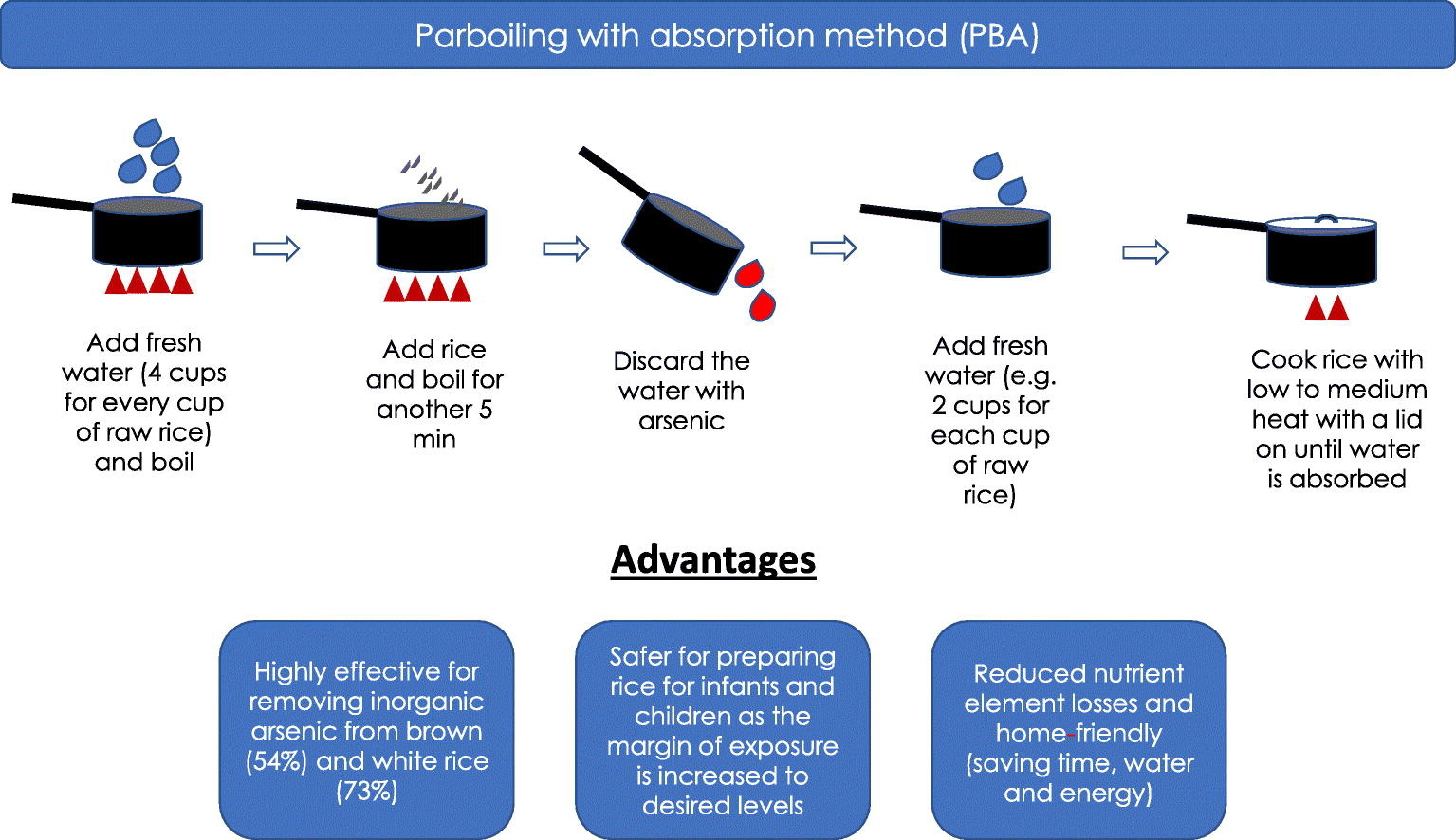Why you should know:
Arsenic is a carcinogen and has various other negative health effects; enough to warrant exposure limits in various jurisdictions. A five minute boil-and-discard step before cooking is a simple way to reduce your exposure, especially if you eat a lot of rice.
Details are in the study, linked in the title of this post. Here’s a diagram from the abstract:

Oh boy, someone better go back and tell all of Asia for the last 10,000 years
This is a growing problem due to climate change (higher temperatures seem to increase arsenic uptake) and pollutants, so this doesn’t make any sense.
Neither the rice species nor the way it is prepared is the same as it was 10000 years ago. India has been producing spices for millenia but the massive amounts of arsenic, cadmium, and lead found in spices sold on the Indian market (and sometimes in Indian exports) is still a recent development.
The world is moving towards a focus on mass production through industrialisation on a record scale. This has an impact on things like the natural water sources, which is where most arsenic in rice is coming from.
Europe has limits on the amount of arsenic in rice, but I’ve never seen a lack of rice varieties in my supermarkets. You can have rice without huge amounts of arsenic, that’s not a weird thing to ask for.
Let’s do the math. Rice contains about 0.4 mg/kg As by weight. The “bad” rice in Louisiana or whatever contains about 75% more - about 0.7 mg/kg. Let’s round up to 1 mg/kg to make the math easy. Chronic exposure limits for a 50 kg adult are about 5 mg/day (on the low end).
So you’d have to choke down a full 10 lb bag of rice every day (about 110 cups of cooked rice) to start to tip the scales. Other sources of arsenic, like groundwater, are likely far more significant.
Comment stolen from reddit
Soooo it’s safe to eat without throwing the eater out?
Well, if you were previously throwing anyone who ate the rice in the garbage, then yes, not doing that would be safe.
sorry, I ^couldn’t ^ resist. yes, it’s safe to eat rice without throwing out the first batch of water. see rest of this thread for nuance.
The microplastics in my body laugh at arsenic’s petty attempt on my life!

Wow, lot to unpack here.
-
“Ain’t nobody got time for that.”
-
How much arsenic are we talking about here?
-
“Saving time, water, and energy” is apparently short for boil water, stand around, drain, re-boil more water using more energy, and finish cooking rice. Where is all this time saving happening?
-
“The margin of exposure [to arsenic] is increased to desired levels”. Hmmm I guess if you really think about it that is a true statement, but one heck of a roundabout way to say it.
The article explains the infographic and adds a lot more context.
The amount of arsenic depends on location - if you’re in a region that has standards on arsenic levels, like the EU, UK, or the US, then you’re probably fine, but the levels may be higher than what’s considered safe for children. This method would allow you to reduce the levels by around 50%, and since the levels for children are a bit under half of what’s acceptable for adults, that’s likely to make it safe for them.
The time savings are relative to other methods for reducing arsenic content, like cooking it with excess water (like a 12:1 ratio) and then discarding the excess, as this method allows you to use a rice cooker for the remaining time and to cook with a much smaller water:rice ratio, even accounting for the discarded water.
-
Ysk your body can naturally get rid of arsenic so this is pointless.
How much arsenic water would you need to distill down to get a useful amount of arsenic?
The only reason I started eating more rice in the last decade or so, was one click cooking. If you want me to use a process more complex than “dump equal rice and water in rice maker then click start”, I’m afraid the alternative is potatoes
Do you “discard” the water by… just letting it into the sink? How long before aresnic is everywhere?
Arsenic is a naturally occurring element.
Does it come with old lace?
It takes 40 mins to fully cook brown rice plus the 5-8 mins it takes for it to boil. This will add 15-20 mins more to overall cooking. As someone who eats rice almost everyday, I’ll probably want to start doing this, but man that’s a lot more time and water wasted 😞
This will add 15-20 mins more to overall cooking.
Are you counting 5-8 minutes to heat water + 5 minutes parboiling the rice + 5-8 minutes to heat fresh water? If so, you’re double-counting one of those steps, because you already have to heat water when cooking rice. Using your figures, the overall cooking time would only increase by 10-13 minutes.
You could reduce that to ~5 minutes by heating your cooking water during the parboil step, rather than after, so it’s ready to go when the parboil is done. In a kettle or second pan, for example.
You could further reduce it to <1 minute (the time it takes to replace the parboil water) by taking 5 minutes off the cooking time, since the newly added 5 minute parboil is cooking.
I hope the fediverse doesn’t cook meals one step at a time. That would take ages. :)
I’m asian and grew up in Asia cooking rice without a rice cooker. This is how we do it:
- 1:2 rice to water ratio
- Wash rice
- Put rice and water in a sauce pan(?) or whataver you call that pan with deep sides.
- Turn on stove to high heat until water boils (This is the initial 5-8 mins)
- Once boiling, turn down heat to low and simmer for 40 mins (for brown rice. White rice is 20-25, broken rice is 12-15)
If I was to boil the rice for 5 mins and throw the water out, that means I need to boil water first (5-8 mins), throw in the rice and wait 5 minutes, then throw out the water. Only then will I do the above steps. The fresh water needs to boil again (5-8 mins) before I simmer for 40 mins.
Good point on heating the new batch of water while doing the initial boil. I can’t say I’ve ever cooked rice by throwing it into already boiling water though, so we’ll see how it turns out.
Scientists of discovered that saliva causes stomach cancer but only when swallowed in small amounts over a long period of time.




